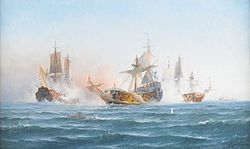Action
In the English channel, off the coast of Sussex, a Dano-Swedish convoy fleet of 180 Swedish and Danish merchant ships, led by the Wachtmeister met an English frigate on 18 April. The English frigate, named the Seahorse began inspecting the merchant ships, and then demanded one of the ships salute it, which was promptly refused, with the answer that the ship behind it would give them the reason for it, which happened to be the Wachtmeister [1] [2] [3]
When the English captain, Anthony Tollet [4] sent his boat onboard the Wachtmeister to know the reason for the refusal to strike their sail, the Swedish captain, Gustaf Wattrang, sent his Lieutenant on board the Seahorse to tell him that the Swedes had orders to not strike to any ship in the world, especially such a "diminutive" one. [1]
Upon hearing the reason, Tollet sent the Lieutenant back to the Wachtmeister, and told him to notify Wattrang that unless he saluted the Seahorse, he would fire his broadside cannons at the Wachtmeister. [1] After this, the Englishmen fired two bullets at the Swedes, but only into the air. [2] [5]
Since the Swedes continued to refuse, Tollet did as he promised and fired a broadside at the Swedes directly aimed towards the main body of the Wachtmeister. Wattrang then directed the Wachtmeister towards the Englishmen, delivering a broadside, leading to a firefight that lasted for more than 3–4 hours. [1] [2] [5]
Since the Seahorse was significantly smaller than the Wachtmeister, it was eventually forced to give up, and retreated, leaving the Dano-Swedish convoy victorious in the battle. [2]
This page is based on this
Wikipedia article Text is available under the
CC BY-SA 4.0 license; additional terms may apply.
Images, videos and audio are available under their respective licenses.
